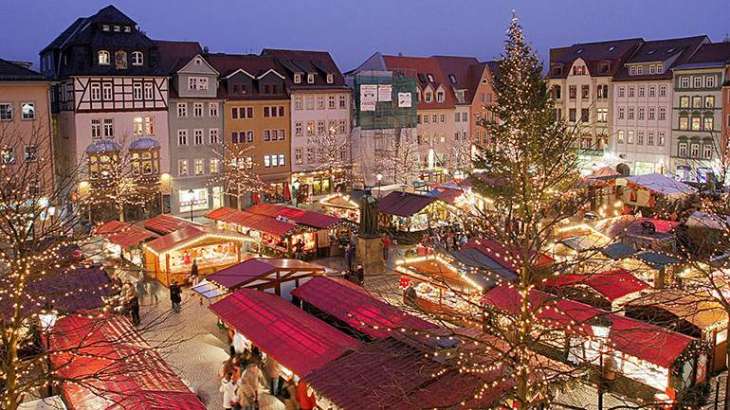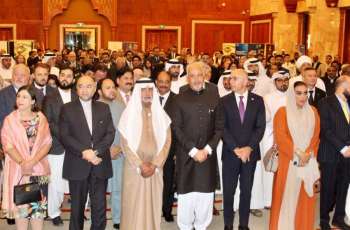On December 25, Western Christian churches celebrate Christmas, a public holiday in many parts of the world that commemorates Jesus Christ's birth.
MOSCOW (Pakistan Point News / Sputnik - 25th December, 2018) On December 25, Western Christian churches celebrate Christmas, a public holiday in many parts of the world that commemorates Jesus Christ's birth.
The decision to celebrate the Nativity of Christ on December 25 was made at the third ecumenical Council of Ephesus in the year of 431 by Roman Emperor Theodosius II.
Though initially celebrated by the Roman Catholic Church, Protestants, including Lutherans, Anglicans, some Methodists, Baptists and Pentecostals, as well as 10 of the 15 Eastern Orthodox churches that use the Revised Julian Calendar � which so far coincides with the Gregorian calendar � also celebrate Christmas on December 25.
Christmas is preceded by Advent, which starts four weeks before Christmas and is supposed to prepare believers for confession in order to participate in Christmas services with a pure heart and to take communion. During Advent, worshipers participate in special pre-Christmas religious services and do works of charity.
A detailed story about Jesus's birth is provided by Luke the Evangelist: "And Joseph also went up from Galilee, from the city of Nazareth, to Judea, to the city of David called Bethlehem, because he was of the house and family of David, in order to register along with Mary, who was engaged to him, and was with child. While they were there, the days were completed for her to give birth. And she gave birth to her firstborn son; and she wrapped Him in clothes, and laid Him in a manger, because there was no room for them in the inn."
The reason why Mary and Joseph went to Bethlehem was the census, which was held during the reign of Emperor Augustus by Quirinius, the governor of Roman Syria. According to the decree of the emperor, every resident of the Roman Empire had to go to his own city to facilitate the census. Since Joseph was a descendant of David, he went to Bethlehem.
After the birth of Jesus, the shepherds were the first people who came to worship him. The shepherds were notified of Christ's birth by an angel of the Lord, who had appeared to them. According to St. Matthew, a miraculous star appeared in the sky and led the three Magi, or Wise Men, to baby Jesus. They gave Christ the three gifts � gold, frankincense, and myrrh. At the time, the Holy Family had already found shelter in an inn.
After learning of Christ's birth, Herod, the king of Judea, ordered that all boys under the age of 2 be killed, but Christ was miraculously saved from death. Despite this, however, Joseph's family had to flee to Egypt and stay there until Herod was dead.
In accordance with the early Roman Christian tradition, which was established in the first centuries of Christianity, three special liturgies are served on Christmas day. These are a midnight Mass, a Mass at dawn and a Mass during the day. Thus, Christmas is celebrated three times: as the eternal birth of the Word of God the Father at midnight, the Virgin Birth of the Son of God at dawn and the birth of God in the soul in the afternoon. Christmas Eve Mass is served in the evening of December 24.
At the beginning of the first Christmas Mass, a procession takes place, during which a priest carries a figure of baby Jesus and puts it in a manger and sanctifies it. The ceremony helps believers to feel as though they are a part of the events that occurred on Christmas night.
Christmas celebrations last eight days, from December 25 to January 1, and are known as the Octave of Christmas. December 26 is celebrated as St. Stephen the Martyr Day, December 27 is marked as the day of John the Apostle and the Massacre of the Innocents is commemorated on December 28.
On Sunday, which falls on one of the days between December 26 to December 31, or on December 30, if none of these days fall on a Sunday, is celebrated as the Day of the Holy Family: baby Jesus, Mary and Joseph. January 1 is celebrated as the Solemnity of Mary, Mother of God.
Christmas time continues even after the Octave until Baptism, which in the Roman Catholic calendar is celebrated on the first Sunday after Epiphany (January 6). During Christmas time, the clergy wear the white robes during liturgies.
Traditionally, the Vatican plants a tree for the holiday. In 2018, a 75.5-feet high tree, weighing 4.5 tonnes, was presented to Pope Francis by the authorities of the Italian autonomous region Friuli-Venezia Giulia. There is a so-called presepe at the foot of the tree. Presepe is a Christmas crib or nativity scene that depicts the scene of Jesus's birth. This year it is made of more than 700 tonnes of sand, which was brought to the Vatican from the resort town of Jesolo on the Adriatic coast.
Most Italians and Vatican residents serve roast beef and sweet Christmas cakes known as panettone or pandoro, which is similar to Easter cake, for Christmas dinner. For Christmas, Italians usually give each other gifts called torroncino, sweets similar to nougat and roasted nuts.
There are traditional regional types of Christmas baking in Germany, such as gingerbread in Nuremberg, shaped gingerbread in Aachen, and Christmas stollen and cinnamon stars in Dresden.
A yule log, a biscuit roll decorated with cream, frosting and chocolate traditionally appears at the Christmas table in many European countries.
Lighted candles are one of the main Christmas symbols. Its flickering flame reminds believers of the words found in the Gospel: "The light shines in the darkness and the darkness has not overcome it."




